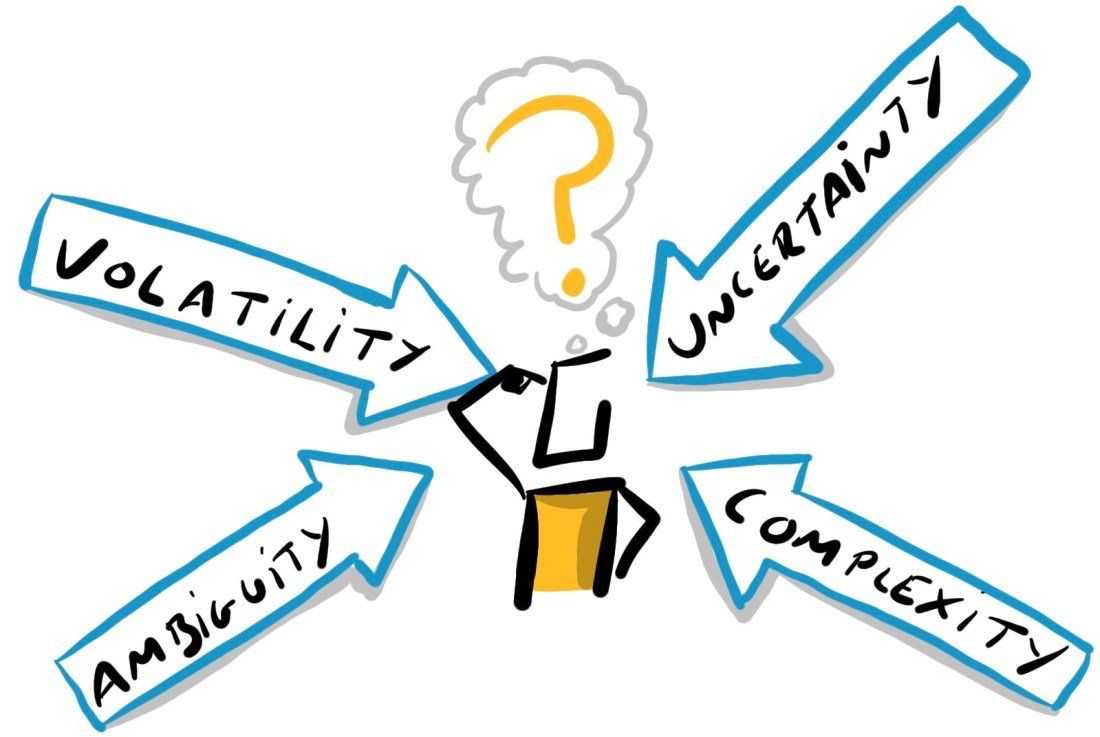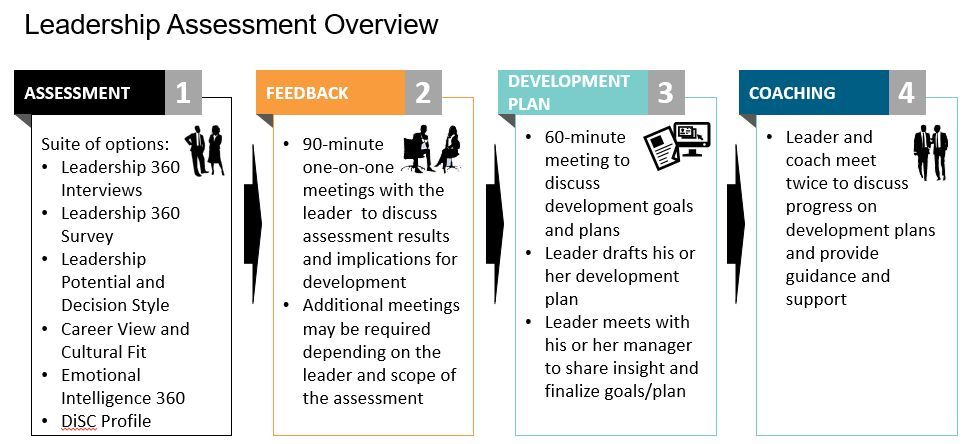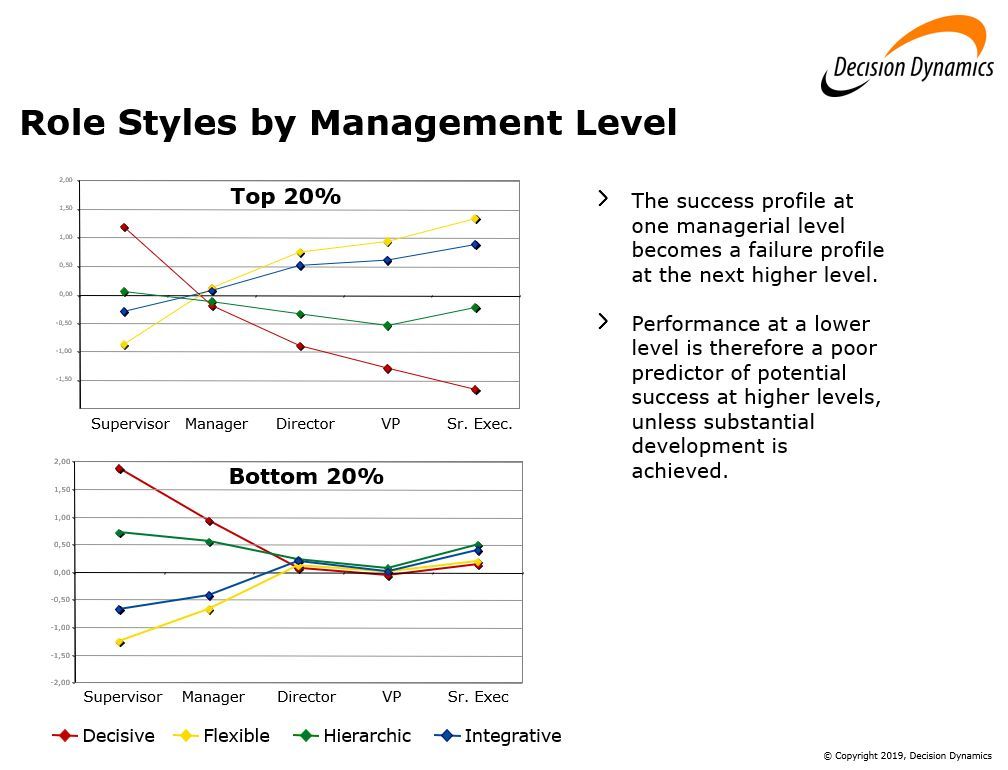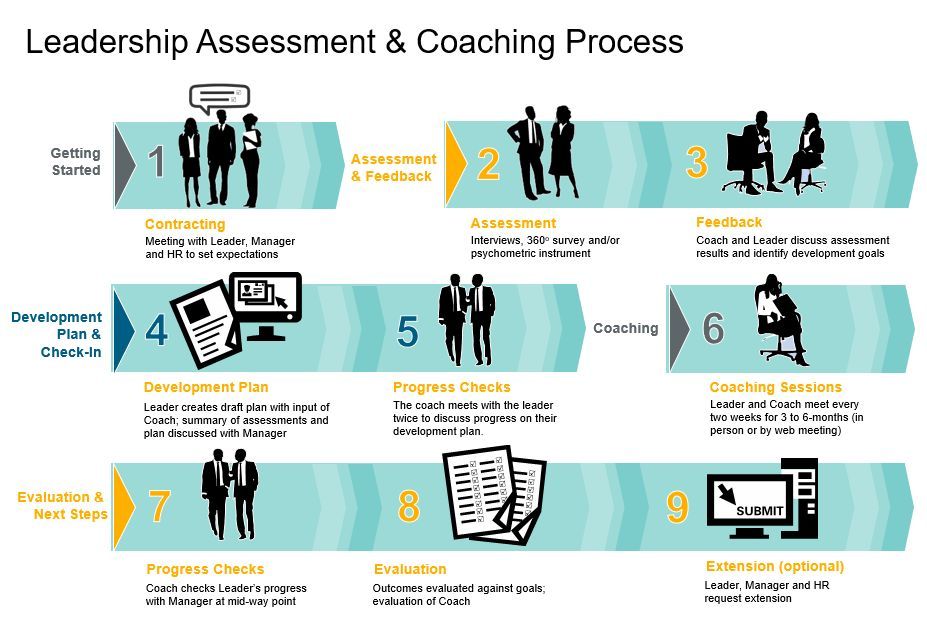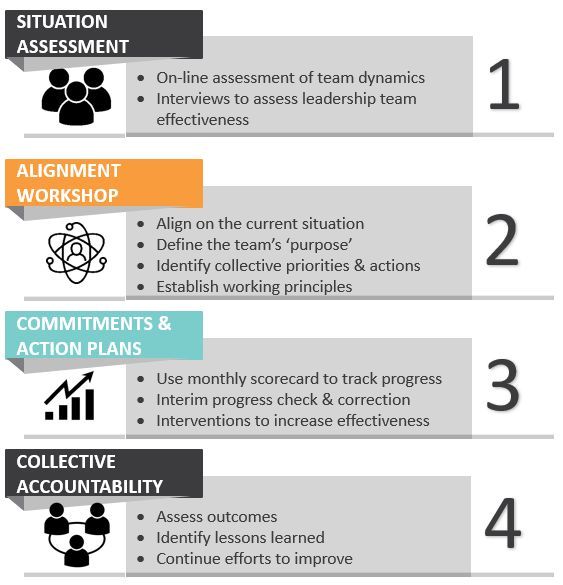Used with individuals and teams, the DiSC profile provides standardized, objective data about each person's personality and behavior, which in turn, helps people understand one another and “get” where each person is coming from. Intact work teams, cross-functional teams, and project teams at all levels benefit from the insights it provides leading to better relationships, improved communications, and stronger collaboration. Also used as part of leadership assessment and coaching, its easy-to-understand model and language provides leaders with insights about their style and preferences and how this influences the way they lead and interact with others. More Information Here
This is where we can help. Working with leaders, we guide them to a deeper understanding of self and their developmental gaps and help them take steps to unleash their leadership potential and create great organizations with great cultures.
Leadership 360 Assessment
As every company and leader is unique, we offer a suite of assessment options to ensure the approach is tailored to your specific context and needs. While important, the assessment is however only the first step in the process. More important is what happens once the assessment is complete. In fact, if you ask others for feedback and nothing changes, an assessment can cause more harm than good by eroding trust and credibility. Not to mention, it can result in skepticism about the process leading to resistance to future efforts of this kind. For this reason, our assessments include feedback, development planning, and two coaching conversations.
Leadership 360 Interview
Our interview-based 360 leadership assessment is recommended for executives and other senior leaders who have significant influence on strategy, people and culture. It not only identifies development needs, but also the strengths the leader can build upon to expand his or her influence and intentionally create a great culture and organization.
The 360 interview provides actionable feedback that goes much deeper than possible through a survey alone. Typically, eight to twelve one-hour interviews are conducted with the leader’s manager, peers, direct reports, and others. These interviews allow for deep probes of the participants’ answers to uncover specific details with examples and context. This makes the feedback more meaningful and credible which results in a higher rate of acceptance of the findings.
Interview questions are customized for the organization and as needed, the individual. Customizing the questions ensures the assessment is context specific and probes areas of particular importance and/or concern. For example, a company that is changing its business model often requires new or different behaviors from leaders. It isn’t that current behaviors are ‘bad’, it is just that new behaviors may be needed for the new business model to be successful.
Leadership 360 Survey
A leadership 360 survey is an effective tool for providing feedback to leaders at all levels of your organization. Similar to the interview-based 360 assessment, the leader’s manager as well as several peers, direct reports, and others rate the leader on different leadership competencies. A detailed report provides benchmarks that allow the leader to compare themselves to high performing leaders who have a similar scope of responsibility. Our preferred 360 survey is The Leadership Circle ProfileTM (LCP).
The Leadership Circle Profile is a true breakthrough among 360-degree assessments. It is the first to connect a well-researched battery of competencies with underlying motivations and
habits of thought. It reveals the relationship between patterns of action and the internal assumptions that drive behavior. The LCP goes to the source of behavior to get greater leverage on change. Furthermore, unlike most leadership 360-degree assessments, the LCP integrates data in a way that brings the key issues to the surface instantly. It immediately gets leaders in touch with what is working, what is not, and why!
If preferred, we can partner with you on the design of a custom leadership 360 assessment survey and/or provide feedback to leaders using your tool. A custom survey typically uses your leadership competencies as the basis for the survey questions and, if needed, augments this with competencies drawn from leadership theory. One drawback of most custom 360 assessments is they don’t provide tested performance benchmarks. While this isn’t essential, it can make it more difficult to convince skeptical leaders they need to change their behavior and/or develop their leadership skills.
Hybrid Leadership 360 – Survey Plus Interviews
A very good alternative to either an interview-based or 360 survey is a hybrid approach. With this option, a leadership 360 survey is conducted followed by a small set of interviews, usually five to eight, to dive deeper into the results and, if needed, ask questions about areas not measured by the survey such as alignment to strategy.
The benefit of the hybrid approach is it combines the value of data and benchmarks with the context and examples provided by interviews. It is effective for all levels of leaders providing powerful insights for action. While the cost is similar to the interview-based 360, it demands less time from the people participating in the assessment and provides a baseline that can be used to measure progress over time.
Emotional Intelligence 360 Assessment
Emotional intelligence (EQ) accounts for
nearly 90 percent of what sets high performers apart from peers with similar technical skills and knowledge. So what is emotional intelligence?
Emotional intelligence is the ability to understand and manage your own emotions, as well as recognize and influence the emotions of those around you.
“The most effective leaders are all alike in one crucial way: They all have a high degree of what has come to be known as emotional intelligence. It’s not that IQ and technical skills are irrelevant. They do matter, but...they are the entry-level requirements for executive positions.” Daniel Goleman, HBR (2015)
The EQi 2.0 360 assessment measures the emotional Intelligence skills critical for leadership, team effectiveness, work performance, influence, work/life balance, and wellbeing. The fifteen competencies in the scientifically validated EQ-i 2.0 model are highly correlated with inspirational leadership (leadership presence), innovative work cultures, highly effective teams, and engaged and committed talent. And the best news – these are learned skills that we can develop and improve!
This assessment is recommended for leaders at all levels who want or need to hone their emotional intelligence skills. Less broad than leadership 360 assessments, it provides targeted and actionable feedback to develop EQ.
Leadership Potential and Decision Style Assessment
Do you know a leader who was a star at a lower level but is struggling after being promoted? Or maybe you know someone who seems to have tons of potential but isn’t performing to expectations. Unfortunately, these are not rare cases.
Research has shown that there are distinct decision styles required to be effective at different levels of leadership. Overuse of more complex decision styles can derail a first or mid-level manager and, similarly, underuse of these same styles can derail senior leaders. The good news is by recognizing they’ve failed to let go of old habits or have jumped too quickly into executive mode, leaders can often get back on track.
See Tools Page Here
Psychometric assessments have long been a go-to tool for evaluating candidates during the selection process however, the right assessment can also be a powerful developmental tool and provide valuable insights into leadership potential. Unlike most psychometric instruments, Decision Dynamics’ Career View and Decision Styles (Executive Suite) is dynamic. It goes beyond static personality traits and drivers to help leaders understand their perceptions and behaviors and how these affect the way they make decisions and lead.
An added benefit of the Executive Suite assessment is the insights it provides into a leader’s emotional behaviors and complexity motives. Emotional behaviors are composed of feelings and impulses that give energy and direction to a person's actions. There is nothing inherently good or bad about a particular emotional behavior level, high or low, apart from the situation in which it is used. A particular emotional behavior level could be too high for one situation, too low for another and just right for yet a different circumstance. As such, the amount of an emotional behavior needed for success in one position might differ sharply from the amount of the same emotional behavior needed to be effective in a different position, company and, perhaps, a different country or culture.
Have you ever felt exhausted at the end of the workday or week and wonder why? The answer may be found in better understanding complexity motives. Complexity motives examine the degree to which people enjoy doing things in complex versus uncomplicated ways. Most of us want some complexity in our activities. When things are totally lacking in complexity, we tend to feel bored and under stimulated. As the tasks and situations we face move from being simple to somewhat complex, we tend to feel more stimulated, interested, and mentally alive. However, as tasks and situations go on getting more and more complex, at some point we move from feeling alive and stimulated to harried and overwhelmed. We all have our "just right" points for handling complexity.
Around these points, we have our "comfort zones" for dealing with complexity. Knowing complexity preferences and use equips leaders with insights as to how they can restructure their work to achieve a better balance and in so doing increase their energy and effectiveness.
DiSC Workplace Everything Profile
Development Plans & Progress Checks
An effective development plan builds on the leader's strengths to make him or her an even better leader, expand his or her influence and achieve his or her career goals. It is not, as some leaders fear, about changing who we are. Our approach is unique in linking personal and culture development in recognition of the powerful influence leaders have on others and the way things happen in the organization. Development planning includes:
- Priority Setting – The leader and the coach identify 2 to 3 potential opportunities for development. The manager, leader and coach align on the development goals.
- Development Plan – The leader and coach work together to create a draft development plan that is reviewed with the leader's manager. The leader refines the development plan, and reviews this with his or her manager.
- Coaching Conversations
- The coach meets twice with the leader during the next month to discuss his or her progress and provide suggestions, guidance, and support.
Click here for an example of a development plan.
Executive and Leadership Coaching
The International Coaching Federation (ICF) reports that “leaders who participated in coaching saw 50 to 70 percent increases in work performance, time management, and team effectiveness.” And that’s just the beginning. Under strong leadership teams, companies benefit from higher productivity, engagement, and retention rates, which profoundly contribute to bottom-line results. In fact, ICF’s 2009 Global Coaching Client Study reported the median coaching ROI to be 700%.
Ten years ago, most companies hired a coach to help fix toxic behavior at the top. Today,
most coaching is about developing the capabilities of high-potential performers, acting as a sounding board during leadership transitions, and helping leaders understand how to act in an increasingly demanding and volatile world.
Dr. Evans is a leadership and culture expert with deep expertise and experience working with executives and other senior leaders in complex organizations. Her unique perspective and expertise mean that coaching sessions focus on the leader's personal development through a culture, strategy, and performance lens. She believes strongly that every leader has more potential and that her role, as coach, is to help people unleash this potential to be the best leader they can possibly be. The objective is to build great leaders and great organizations with great cultures! Coaching includes:
- Introductory Meeting - Face-to-face or virtual meetings with the leader, manager, and/or Human Resources to clarify expectations, discuss roles and the confidentiality of information, and explain the coaching process.
- Coaching Sessions – The coach and leader meet for 1 hour at regular, agreed intervals (preferably once every 2 weeks). The number of coaching sessions depends on the length of the engagement (3, 6 or 9 months).
- Interim Progress Checks – The coach connects with the manager at predetermined points in the coaching process to obtain feedback on the leader’s progress and make course corrections if needed. This typically occurs once but can be more frequent if needed.
- Evaluation - At the end of a coaching engagement, the leader, manager, Human Resources, and coach discuss the progress made and next steps.
Leadership Team Effectiveness
One might assume that operating as a cohesive, high-performing team should be the goal of senior leaders. Yet, this is often far from the reality in many organizations. Simply put, operating as a team conflicts with strong independent leadership and the power dynamics created by hierarchical relationships. Furthermore, strong independent leadership works most of the time. Does this mean senior leaders don’t need to work as a team?
The answer is a resounding NO.
“In reality, long-term success depends on the whole leadership team, for it has a broader and deeper reach into the organization than the CEO does, and its performance has a multiplier effect: a poorly performing team breeds competing agendas and turf politics; a high-performing one, organizational coherence and focus.”
While there is work that can and should be done independently, the complex and often difficult to predict situations facing organizations today requires teamwork at the top. More specifically, it requires that leaders with
diverse, yet complementary skills work together to understand complex situations, explore options, make decisions, and lead execution. When senior leaders work together effectively as a team, they also acquire a deeper appreciation of each others’ talents, develop mutual respect, and a shared belief in the value of what they can accomplish together.
Leadership Retreats
Leaders are the single most important factor influencing culture. When a critical mass of leaders is aligned, culture can change in months versus years. This is what we call the amplifying effect of leaders - leaders leading the way by role modeling expected behaviors embedded in day-to-day practices and supported by an environment with the right conditions for success.
Leaders Creating Great Cultures Together. Tailored to your specific needs and situation, our Leadership Retreats are anchored by the business challenges and opportunities facing your organization. This provides the backdrop for examining the way senior leaders, individually and as a team, are influencing culture and the organization's ability to execute strategy and achieve your goals. The insights gained provide focus for activities and discussions aimed at building the leader and team capability required to intentionally create great cultures and organizations.
Leadership Retreats are typically held off-site and range in length from one to three days. They are led by culture and leadership experts with world class facilitation skills and extensive experience working with C-Suite executives. With access to the wide range of assessment instruments, tools, activities, and other resources available in the CULTURESTRATEGYFIT® Resource Center, we partner with you to create a high impact experience that leaders will remember for years to come. Typical objectives of our retreats include:
- Strengthen the effectiveness and culture of the leadership team.
- Understand how leaders’ personal traits and preferences affect relationships, team performance, and culture.
- Identify culture strengths and gaps between your current culture and the culture you need to execute your strategy.
- Align the leadership team on a shared vision of the culture you need to execute your strategy.
- Build leader capability to create the culture you need to execute your strategy.
- Develop a 90-day action plan owned and executed by the leadership team.
Click
here for a sample outline.



